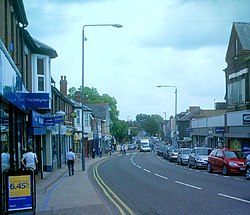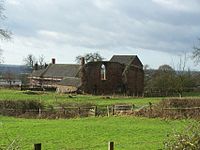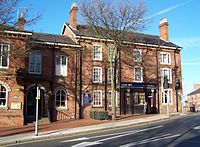Eastwood, Nottinghamshire: Difference between revisions
mNo edit summary |
|||
| (2 intermediate revisions by the same user not shown) | |||
| Line 14: | Line 14: | ||
|constituency=Ashfield | |constituency=Ashfield | ||
}} | }} | ||
'''Eastwood''' is a former coal mining town in [[Nottinghamshire]], with a population of over 18,000. It is | '''Eastwood''' is a former coal mining town in [[Nottinghamshire]], with a population of over 18,000. It is eight miles north-west of [[Nottingham]] and 10 miles north-east of [[Derby]], on the border between Nottinghamshire and [[Derbyshire]]. | ||
Eastwood is listed in [[Domesday Book]]. It expanded rapidly during the Industrial Revolution. The Midland Railway was formed here, and it is the birthplace of D H Lawrence. | Eastwood is listed in [[Domesday Book]]. It expanded rapidly during the Industrial Revolution. The Midland Railway was formed here, and it is the birthplace of D H Lawrence. | ||
==Geography== | ==Geography== | ||
D H Lawrence wrote: | D H Lawrence wrote: | ||
| Line 56: | Line 54: | ||
|last2=Worthen | |last2=Worthen | ||
|first2=John | |first2=John | ||
|publication-date=1996 | |publication-date=1996 | ||
|edition=illustrated | |edition=illustrated | ||
| Line 65: | Line 62: | ||
|accessdate=2009-02-28 | |accessdate=2009-02-28 | ||
|year=1996 | |year=1996 | ||
}}</ref> | }}</ref> | ||
| Line 120: | Line 116: | ||
|accessdate=2008-05-11 | |accessdate=2008-05-11 | ||
|year=1989 | |year=1989 | ||
}} Essay 8: The Sense of History in The Rainbow by Mark Kinkead-Weekes</ref> By 1880 the population had increased to 4,500.<ref name=plumb>{{Cite journal | }} Essay 8: The Sense of History in The Rainbow by Mark Kinkead-Weekes</ref> By 1880 the population had increased to 4,500.<ref name=plumb>{{Cite journal | ||
|year=2004 | |year=2004 | ||
| Line 129: | Line 124: | ||
|url=http://www.eastwood-town-council.org.uk/htmfiles/history.html | |url=http://www.eastwood-town-council.org.uk/htmfiles/history.html | ||
|accessdate=2008-05-01 | |accessdate=2008-05-01 | ||
}}</ref> | }}</ref> | ||
Factories were built to accommodate the new industries, land becoming available for them as the rural population moved to urban areas. This industrialisation of the countryside was only restricted from the early 19th century, when, somewhat belatedly, the effect of the Enclosures began to be felt in Nottinghamshire.<ref name=histbrox/> In a local manifestation of this period of upheaval, marchers of the Pentrich Revolution of 1817 passed through the town, and were met by soldiers at nearby Giltbrook: the residents of Eastwood boarded up their houses and hid in the woods. | Factories were built to accommodate the new industries, land becoming available for them as the rural population moved to urban areas. This industrialisation of the countryside was only restricted from the early 19th century, when, somewhat belatedly, the effect of the Enclosures began to be felt in Nottinghamshire.<ref name=histbrox/> In a local manifestation of this period of upheaval, marchers of the Pentrich Revolution of 1817 passed through the town, and were met by soldiers at nearby Giltbrook: the residents of Eastwood boarded up their houses and hid in the woods. | ||
| Line 140: | Line 134: | ||
|url=http://www.broxtowe.gov.uk/index.aspx?articleid=2256 | |url=http://www.broxtowe.gov.uk/index.aspx?articleid=2256 | ||
|accessdate=2008-05-01 | |accessdate=2008-05-01 | ||
}}</ref> | }}</ref> | ||
| Line 151: | Line 144: | ||
|url=http://www.nottingham.ac.uk/mss/collections/dhl-resources/biog-full/ | |url=http://www.nottingham.ac.uk/mss/collections/dhl-resources/biog-full/ | ||
|accessdate=2009-02-28 | |accessdate=2009-02-28 | ||
}}</ref> Although the coal boom ended during Lawrence's childhood, Eastwood continued to expand, Nottingham Road and its feeder streets became established as a shopping area. However, few jobs remained outside what remained of the coal industry. Most women were housewives, and boys were desperate to reach the age of fourteen, when they could start working in the mines. In the early 20th century, trams provided a new means of transport between [[Nottingham]], [[Ripley, Derbyshire|Ripley]] and [[Heanor]]. Lawrence lived next to the line, and described it as the most dangerous tram service in the land. | }}</ref> Although the coal boom ended during Lawrence's childhood, Eastwood continued to expand, Nottingham Road and its feeder streets became established as a shopping area. However, few jobs remained outside what remained of the coal industry. Most women were housewives, and boys were desperate to reach the age of fourteen, when they could start working in the mines. In the early 20th century, trams provided a new means of transport between [[Nottingham]], [[Ripley, Derbyshire|Ripley]] and [[Heanor]]. Lawrence lived next to the line, and described it as the most dangerous tram service in the land. | ||
| Line 172: | Line 164: | ||
|postscript=<!--None-->}}</ref> | |postscript=<!--None-->}}</ref> | ||
A war memorial was unveiled in 1921, inscribed "''to the men of Eastwood, who fell in the | A war memorial was unveiled in 1921, inscribed "''to the men of Eastwood, who fell in the Great War 1914-1918''." Later, Second World War dedications were added, and it was moved to its present location at Plumptre Way. It is in the shape of an obelisk, made of Italian marble with a base of Whatstandwell stone.<ref name="warmem"> | ||
{{NHLE|495784|War Memorial}}</ref> | {{NHLE|495784|War Memorial}}</ref> | ||
Latest revision as of 16:41, 30 July 2018
| Eastwood | |
| Nottinghamshire | |
|---|---|
 Nottingham Road, Eastwood | |
| Location | |
| Grid reference: | SK465469 |
| Location: | 53°1’3"N, 1°18’22"W |
| Data | |
| Population: | 18,612 |
| Post town: | Nottingham |
| Postcode: | NG16 |
| Dialling code: | 01773 |
| Local Government | |
| Council: | Broxtowe |
| Parliamentary constituency: |
Ashfield |
Eastwood is a former coal mining town in Nottinghamshire, with a population of over 18,000. It is eight miles north-west of Nottingham and 10 miles north-east of Derby, on the border between Nottinghamshire and Derbyshire.
Eastwood is listed in Domesday Book. It expanded rapidly during the Industrial Revolution. The Midland Railway was formed here, and it is the birthplace of D H Lawrence.
Geography
D H Lawrence wrote:
...I was born nearly forty-four year ago, in Eastwood, a mining village of some three thousand souls about eight miles from Nottingham, and one mile from the small stream, the Erewash, which divides Nottinghamshire from Derbyshire. It is hilly country, looking west to Crich and towards Matlock, sixteen miles away and east and northeast towards Mansfield and the Sherwood Forest district. To me it seemed, and still seems an extremely beautiful countryside, just between the red sandstone and oak trees of Nottingham and the cold limestone, the ash trees, the stone fences of Derbyshire
— D H Lawrence, 1929 Nottingham & the Mining Country[1]
The area contains coal measures, with shale, mudstone, and sandstone, overlain by yellow clay. Alluvial deposits from the River Erewash run roughly north-south.[2]
The town is centred on Nottingham Road, which runs along a north west-south east ridge. This road contains many shops and uphill to the east it leads to the A610 to Nottingham, the M1 motorway, and Giltbrook Retail Park. At the western end of Eastwood a gyratory system has been constructed upon an ancient crossroads, now a traffic island, around the Sun Inn public house. Church Street has several listed buildings, and leads on into New Eastwood.
The town is still surrounded by farmed land, woods and fields, and just half a mile to the west, the River Erewash forms the boundary between Nottinghamshire and Derbyshire. Alongside the river, the Erewash Canal leads to the River Trent.
A large hill, visible when looking north from the town, is known locally as "dot hill", "dirt hill", or "bum hill." This land has been reclaimed from a former slag heap.
Churches
St Mary's Parish Church is a modern church, but it has stood on its site since 1250. The remains of the original thirteenth century structure are visible but few. The church was enlarged in 1826 but largely replaced in 1858. The church was almost destroyed by fire in 1963 and only the tower remained; the rest of the present building was added in 1967, and consecrated on 25 September.

Beauvale Priory was founded in 1343 by Nicholas de Cantelupe. One of nine Carthusian houses this side of the sea which owed allegiance to the Grande Chartreuse, the monks' rules were similar to those of Benedictine Order.[3] The monastery was suppressed in 1539, but it lives on in Lawrence's White Peacock as "the Abbey."[4]
Churches in the area include:
- Church of England: St Mary's
- Baptist: Eastwood Baptist Church
- Eastwood Church of Christ, Seymour Road
- Pentecostal: Assemblies of God
- Roman Catholic: Our Lady Of Good Counsel
History
There is some evidence to suggest that the land around Eastwood was occupied in the Middle and Late Palæolithic periods. Stronger indications of later settlement include fragments of characteristic Bronze Age pottery, weapons, and dug-out canoes, which are now preserved at Nottingham Castle, and at the University of Nottingham.[5]
The location of the town is due primarily to the availability of rich agricultural land, the proximity of the River Erewash and—most importantly—the extensive and easily mined coal deposits.[5]
It is mentioned in Domesday Book as Estewic, part of the fee of William Peverel:
In Estewic [Ulfketel] had 4 bovates of land [assessed] to the geld. [There is] land [...] It is waste. William [Peverel] has the custody of it. [There is] woodland pasture 3 furlongs long and 3 broad. In King Edward's time it was worth 5 shillings.
During the Anarchy, the 12th century civil war between Stephen of Blois and supporters of Matilda, the mother of the eventual king, Henry II, Peveral's son, William Peverel the Younger, forfeited these estates to the Crown in 1155.[5] The estate, called the Peverel Honour, was eventually divided, and much of the land around Eastwood was granted to the Greys of Codnor Castle.
Tenant farming prevailed throughout the Middle Ages, whilst common pasture was mainly used for grazing. When King James VI of Scotland became King James I of England in 1603, Eastwood had a population of about 170, and it remained a small village until the 18th century when, in 1779, the Trent Navigation Company opened the Erewash Canal.[6] This was one of the first man made waterways in Britain, with locks at Beeston linking Eastwood to the River Trent and Nottingham, and its arrival led to a rapid expansion of the local coal mining industry. Other industries soon followed, including framework knitting, milling, pottery, brewing, rope making and brick making.
The town expanded rapidly during the Industrial Revolution, and in the 19th century it experienced the greatest increase in population density of any parish in Nottinghamshire.[7] By 1880 the population had increased to 4,500.[8] Factories were built to accommodate the new industries, land becoming available for them as the rural population moved to urban areas. This industrialisation of the countryside was only restricted from the early 19th century, when, somewhat belatedly, the effect of the Enclosures began to be felt in Nottinghamshire.[5] In a local manifestation of this period of upheaval, marchers of the Pentrich Revolution of 1817 passed through the town, and were met by soldiers at nearby Giltbrook: the residents of Eastwood boarded up their houses and hid in the woods.

In 1832, a historic meeting took place at the Sun Inn (built 1750), which resulted in the creation of the Midland Counties Railway, and the construction of a line from Pinxton to Leicester. Industrialisation continued with the opening in 1868 of Moorgreen Colliery, and in 1875 the demand for coal resulted in a railway station in Eastwood, with services to Nottingham on the Great Northern Railway.[9]
D H Lawrence was born there in 1885. Although the local area is mentioned in many of his novels, it is especially featured in The White Peacock, against a backdrop of industrialisation. There were ten coal mines, or "pits", within easy walking distance of Lawrence's home, and the overwhelming majority of the local male population were colliers.[10] Although the coal boom ended during Lawrence's childhood, Eastwood continued to expand, Nottingham Road and its feeder streets became established as a shopping area. However, few jobs remained outside what remained of the coal industry. Most women were housewives, and boys were desperate to reach the age of fourteen, when they could start working in the mines. In the early 20th century, trams provided a new means of transport between Nottingham, Ripley and Heanor. Lawrence lived next to the line, and described it as the most dangerous tram service in the land.
In 1946, the coal industry was nationalised, and the new National Coal Board acquired Eastwood Hall as their Area Office. This later became their National Office, and was the location for several crisis meetings during the national Miners' Strike of the 1980s. At the height of its production in 1963, Moorgreen Colliery alone produced one million tons of coal, but the last coal mine in the area closed in 1985.[9]
In recent years, tourism has become increasingly important. Lawrence's birthplace is now a museum, and a painted line on the pavement, called the "Blue Line Trail," guides visitors around eleven sites of local interest including three of Lawrence's homes.
Sights of the town
The Buildings is a housing estate, consisting of some 300 terraced miners' cottages, built in the 1860s. They were saved from demolition by a council scheme in 1977.
Colliers' Wood is a 35-acre community woodland, part of the Greenwood Community Forest, created in 1996/97 to reclaim some of the woodland and fields destroyed by the mining developments. Over 17,500 trees and hedgerows were planted, and two ponds created. The footpath is made from reclaimed shale.[11] Habitats cater to a wide variety of birds, including mute swans, goldfinches, lesser redpoll, skylarks, and willow warblers.[12]
A war memorial was unveiled in 1921, inscribed "to the men of Eastwood, who fell in the Great War 1914-1918." Later, Second World War dedications were added, and it was moved to its present location at Plumptre Way. It is in the shape of an obelisk, made of Italian marble with a base of Whatstandwell stone.[13]
The Library, opened in 1975, includes an extensive collection of books by and about D H Lawrence. Also on view is Lawrence's desk, and the headstone from his grave in Vence in France.
Greasley Castle (c.1341) was founded by Nicholas de Cantilupe. The remains are now covered by Greasley Castle Farmhouse (c. 1800), which incorporates fragments of mediæval masonry.[14]
The Blue Line Trail - painted along the pavement - guides visitors around the areas connected with the author D H Lawrence and include the D H Lawrence Birthplace Museum, established as a working class Victorian House, Durban House Heritage Centre with Lawrence exhibition, The Rocking Horse Bistro and art gallery and the three other houses in which Lawrence lived.[15]
Eastwood Hall was the headquarters of the National Coal Board then British Coal. It is now a conference centre.
The Man In Space public house was built in the 1960s. It appeared briefly in the film Carry On at Your Convenience.
Transport
The M1 motorway runs close to Eastwood (junctions 26 and 27).
The nearest railway station is at Langley Mill, which has connections to Nottingham, Sheffield, Chesterfield and Manchester.
Sports
- Basketball: Eastwood Antz Basketball Club play at Eastwood Sports Centre
- Cricket: Eastwood Town Cricket Club
- Football: Eastwood Town FC, known as the Badgers, play at Coronation Park
Culture and community
Eastwood Collieries' Male Voice Choir formed in 1919. They appeared on BBC television in 1963, and are one of the oldest surviving colliery choirs in the UK.[16]
Eastwood Arcadians are a local marching band.
Eastwood Theatre is home to local, national and international theatre. Its programme showcases dance, music and drama from professional and amateur performers.
Media
- Newspaper: The Eastwood and Kimberley Advertiser
Outside links
- D H Lawrence Heritage Centre
- Information and photos of Colliers Wood from Rise Park Nottingham web site
- Information and photographs about Eastwood by a local resident, creating a pictorial view of DH Lawrence's relationship with the town
References
- ↑ Lawrence, D.H. (2004). Late Essays and Articles.. Cambridge University Press. pp. 287. ISBN 0-521-58431-0.
- ↑ "Eastwood Conservation Area Character Appraisal" (PDF). Nottinghamshire County Council. 2007-11-21. http://www.broxtowe.gov.uk/media/pdf/k/s/pdf4355349149028534135.pdf. Retrieved 2008-05-01.
- ↑ Cornelius Brown (1896). "The History of Nottinghamshire". Nottinghamshire history. http://www.nottshistory.org.uk/Brown1896/beauvale.htm. Retrieved 2008-05-01.
- ↑ Poplawski, Paul; Worthen, John (1996). D.H. Lawrence: A Reference Companion (illustrated ed.). Westport, Connecticut: Greenwood Publishing Group. p. 155. ISBN 978-0-313-28637-7.
- ↑ 5.0 5.1 5.2 5.3 History of Broxtowe. Broxtowe Borough Council. http://www.broxtowe.gov.uk/index.aspx?articleid=235. Retrieved 2008-05-29
- ↑ History - The beginning. Erewash Canal Preservation and Development Association. 1945-11-24. http://www.erewashcanal.org.uk/history.html#Construction. Retrieved 2008-05-01
- ↑ Preston, Peter; Hoare, Peter (1989). D. H. Lawrence in the modern world (illustrated ed.). Cambridge: Cambridge University Press. p. 125. ISBN 0-521-37169-4. Essay 8: The Sense of History in The Rainbow by Mark Kinkead-Weekes
- ↑ Plumb, Malcolm (2004). The History of Eastwood. Broxtowe Borough Council. http://www.eastwood-town-council.org.uk/htmfiles/history.html. Retrieved 2008-05-01.
- ↑ 9.0 9.1 Tourism, Arts & Leisure - Colliers Wood. Broxtowe Borough Council. 1945-11-24. http://www.broxtowe.gov.uk/index.aspx?articleid=2256. Retrieved 2008-05-01.
- ↑ Worthen, John (1997). Biography of DH Lawrence. D.H. Lawrence Centre, University of Nottingham. http://www.nottingham.ac.uk/mss/collections/dhl-resources/biog-full/. Retrieved 2009-02-28.
- ↑ "Estwic - the community website for Eastwood". http://www.estwic.co.uk/index.php?option=com_content&task=view&id=32&Itemid=9. Retrieved 2008-05-29
- ↑ Moorgreen, Annesley and Colliers Wood. Nottinghamshire Birds. http://www.nottmbirds.org.uk/sites/Moorgreen.html. Retrieved 2008-06-01
- ↑ National Heritage List 495784: War Memorial
- ↑ "Greasley Castle". CastleUK.net. http://www.castleuk.net/castle_lists_midlands/129/greasleycastle.htm. Retrieved 2008-05-19.
- ↑ "Tourism, Arts & Leisure - The Blue Line Trail". Broxtowe Borough Council. http://www.broxtowe.gov.uk/index.aspx?articleid=2263. Retrieved 2008-05-01.
- ↑ Eastwood Collieries Male Voice Choir. "History of the Choir 1920 to Date". http://www.eastwoodcollieriesmvc.co.uk/. Retrieved 2008-05-01.